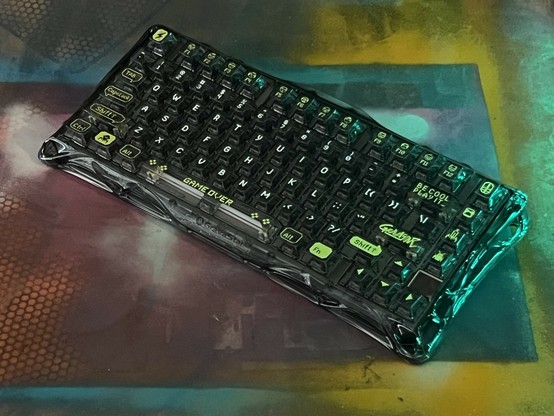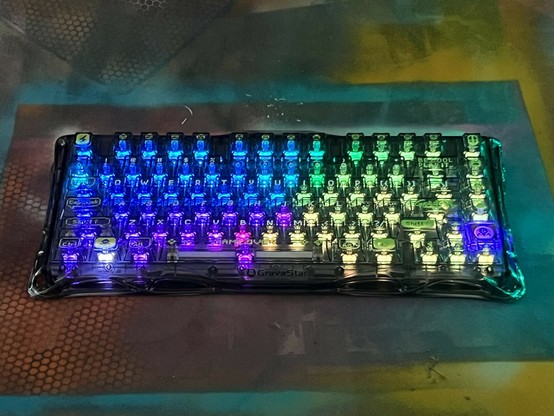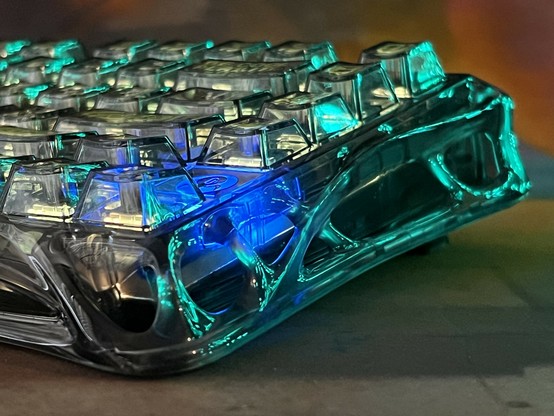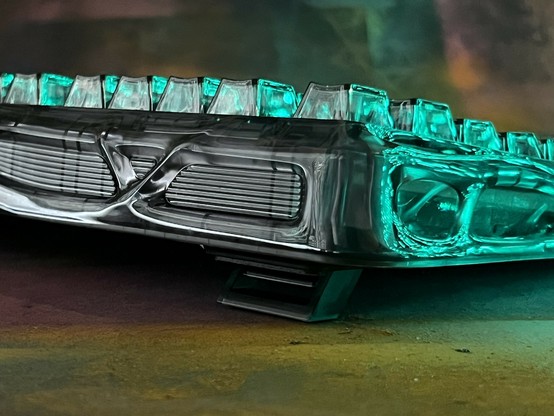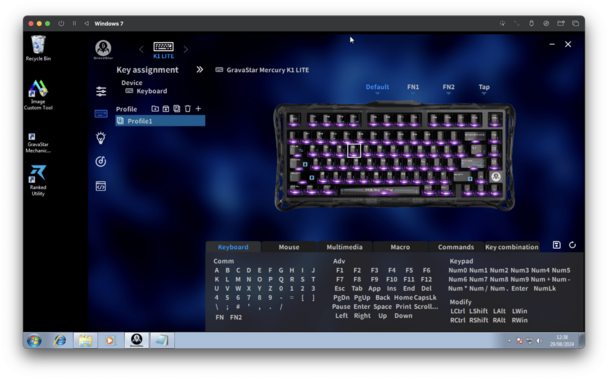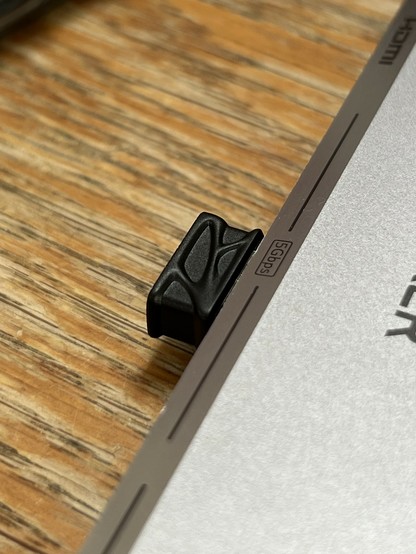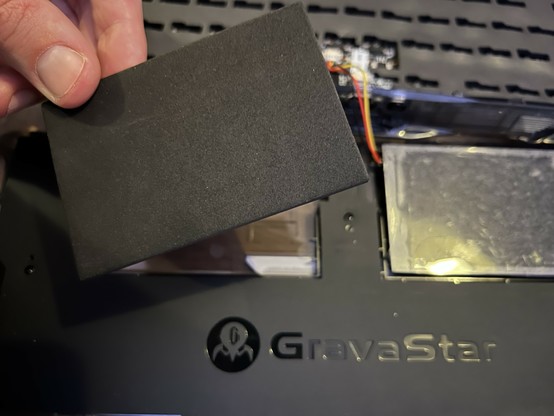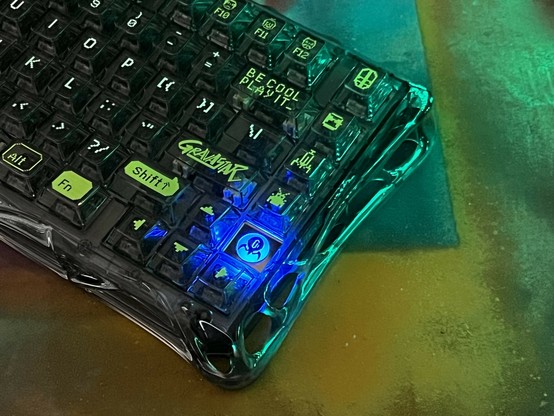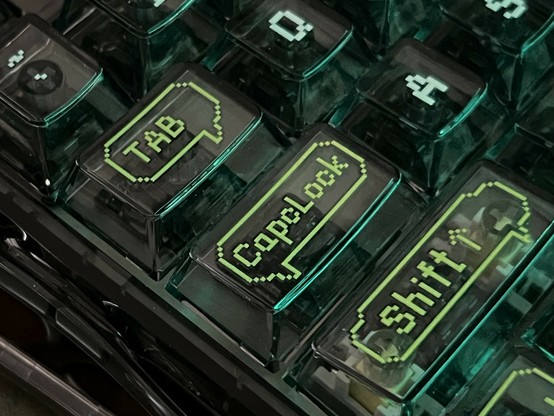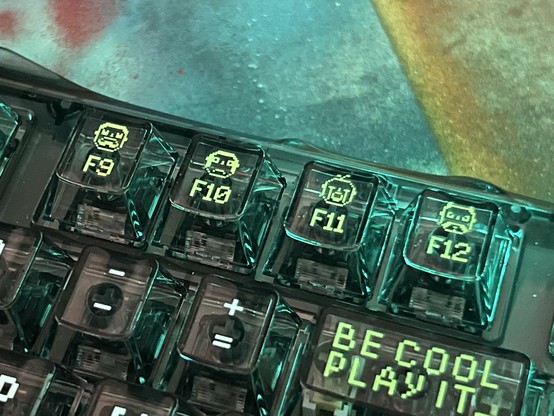Gravastar Mercury K1 Lite in Transparent Black Reviewed
GravaStar were not a company on my radar, but they sure are an interesting one. Imagine your everyday computing and tech paraphernalia – boring and utilitarian, right? Not GravaStar, they have dialled the “form” slider up last 11 and produce stuff that can only really be described as buck wild. Seriously – they have a Bluetooth speaker – the Mars Pro (not to be confused with the Nebula Mars Pro projectors) – that looks like a little tripedal robot and… it’s awesome.
They cropped up out of the blue one afternoon and said – in not so simple terms – “hey, we’re launching mechanical keyboards, want to try one?”
The keys don’t look so bad at a glance but could definitely have been better!
I did want to try one, and for the purposes of this review they sent me their Mercury K1 (not to be confused with the Keychron K1) Lite in transparent black.
The Mercury K1 is a keyboard I absolutely understand and want to love, but it falls a hair short of perfect. In fact it fails in the classic the-keycaps-oh-god-the-keycaps way, where everything else is great but for some reason the keycaps are… not.
Of course GravaStar have beaten me to the punch here and confirmed they’ll be launching a Snow White version of the K1 Lite which takes the same basic form but makes everything white, clean and minimalistic. This- I think- will be a great juxtaposition with the complicated, organic design of the K1 Lite and really make for something quite cool. Regrettably I have the transparent black version, so that’s the one I’ll be talking about!
Look ‘n’ Feel
GravaStar’s bread and butter is bold, striking and extremely out there designs which toe the line between desk ornament and functional product. The K1 Lite isn’t an exception but – in contrast to the bigger, badder K1 Pro – pares their typical formula back to create something that’s not too shouty but is definitely a bit different.
The Mercury K1 Lite, summed up in a word, would be alien. It takes some very obvious design cues from the film’s titular alien and associated architecture to create something immediately familiar and perhaps appealing to fans of the series and the aesthetic. It fuses complex organic curves with a more technological, space-ship-like main casing – if you’re thinking “that’s a bit like the film!” you’d be right. It’s very much the vibe it’s aiming for and it works, to an extent.
Rainbow!
Since creating complex organic shapes out of aluminium might be tricky and expensive (indeed the aluminium K1 is a full £40 more expensive than the Lite), the K1 Lite is made from plastic (PVC). This is a pretty stark contrast to many of the keyboards I’ve tested lately, and it feels a little lacking as a consequence. On the upside it’s lightweight, inexpensive, and it still has all the trappings of a mech keyboard. That includes hot-swappable switches – GravaStar’s “Crystal Black” – linear switches which have integrated LED diffusers for the full RGB backlighting. You’ll also find a cantilever suspended top plate giving the whole keybed some play, though it does bottom-out onto the rubber internal padding in the lower half of the keyboard. The PCB is padded below with the standard foam rubber and padding is also inserted between plate and PCB. All this combines to give the K1 Lite a fairly typical bottom-out soundscape, with the linear switches hitting their limit being the source of that sought-after mechanical cacophony. In short: it sounds good, not too loud, not too sharp.
True to the rest of their lineup they really went full send on the alien styling!
I found the Crystal Black switches to be a little heavy, which no doubt contributes to the muted sound, they’re ostensibly 40gf so perhaps my fingers have become too accustomed to laptops again.
Since the K1 Lite is made from PVC it’s very, very lightweight compared to some of the hulking beasts I’ve tested before. It’s also quite flexible with the whole keyboard having a noticeable twist and flex. Fortunately the internal components are designed to bend, so this will do it no harm.
The fold out feet are chonky and decent!
Finally the bottom has rubber feet at the four corners, plus two stage fold-out feet to give a total of three typing angles. The feet snap out with a satisfying thunk.
Software
The Mercury range are, thankfully, not QMK-based (though who knows if they run it internally) and thus not encumbered with a nightmare of gotchas and caveats. If you want to re-bind keys or change functions you’ll need GravaStar’s own software. GravaStar supplied me with a download link for this. It’s a small download, too, suggesting none of that bloated web-app tomfoolery, but unfortunately it doesn’t run on Mac or Linux. As such I wont cover it in depth in this review, but I did fire up UTM on macOS running a Windows 7 virtual machine and install the software into that.
The GravaStar Mercury K1 software is competent but basic. On the upside it's only a 7mb download which is more (or less) than I can say for most software these days.
The software is a pretty standard fare, showing keyboard info including firmware version and offering debounce tuning along with the usual wealth of macro and key re-binding features. You have four layers- Default, FN1, FN2 and Tap though it seems impossible to tell at a glance what’s bound to which key. You can bind keyboard keys, mouse buttons (and scroll wheel), multimedia actions, macros, commands and key combos.
There’s also lighting control, but this is much quicker and easier to accomplish via the keyboard shortcuts. Suffice to say the software is usable if you’re determined, but it’s quite clunky.
The K1 Lite has tri-mode connectivity with a switch for 2.4GHz, Bluetooth or Wired. The 2.4GHz dongle is stored in the bottom of the keyboard, attached magnetically in a little recess. Nice touch. It’s a really nice dongle, too, I’ve found this to be a place where the likes of KiiBOOM and Epomaker cut corners, but the GravaStar dongle is styled to match the keyboard, peppered with compliance markings and feels pretty decent.
Even the USB dongle is styled, which is a pleasant upgrade over some of the cheap feeling, plain looking competition!
Surprisingly the software also detects the keyboard through the 2.4GHz dongle (other keyboards have been hit and miss with this) so you can run full wireless and still access the settings, at least in theory- as I was unable to save any changes over 2.4GHz but my weird virtual machine setup might have had something to do with this.
2.4GHz pairing mode can be entered by holding Fn + ~ for three seconds and plugging the receiver into your computer, but in practice it’s paired by default so you should not need to do this.
There are, as usual, three Bluetooth profiles for three separate devices. These are accessed with Fn + 1, Fn + 2 and Fn + 3 respectively which will flash the corresponding backlight. Despite the very custom keycaps there is no indication of this on the board at all.
In addition to the connectivity hotkeys there are some controls for the various backlight patterns, Fn + the arrow up/down keys will increase/decrease brightness, and left/right will decrease/increase the effect speed. Fn + \ will change effect and Fn + Tab will change colour. There are also some Fn key alternatives for PgUp/PgDn which double as Home and End, for the U key, which becomes Print Screen, for Del which becomes Insert, I for Scroll Lock, O for Pause. Finally there’s Fn + B to show the battery indicator which, when held down, lights up the number row.
Where GravaStar score full marks is backlight PWM. Their backlight is smooth and consistent and doesn’t look distorted when I snap photos. This basically means that the frequency that the LEDs are turned on/off to achieve colours between just solid red, blue or green is fast enough that even my camera shutter can’t catch it.
Teardown
Despite the flex it never feels flimsy, the top and bottom halves (surprisingly easy to separate) are held together with eight hex bolts, two of which are hidden under the outer ends of the rubber feet and are easy enough to get to. The bolts screw directly into the plastic housing, though, so you probably shouldn’t take it apart unless you really, really need to.
There are no frustrating plastic clips securing the top and bottom halves, which is a refreshing change for a plastic keyboard. The extreme edges – where the curvy alien bits extend past the edges of the keyboard – are clipped somewhat, but these are small and release easily.
Mmm fake foam battery! The K1 has one more battery than the Lite and is made out of metal but apparently they share the same CAD!
My first discovery upon removing the bottom was a chunk of blanking foam. I’ve encountered a few keyboards that have a couple of LiPo battery packs and the Mercury K1 Lite appears to have accommodation for this in the design. However only one battery is installed, and the other recess in the bottom casing is simply filled with a piece of black high density foam. On the plus side the battery disconnects from the PCB with a simple and standard JST connector and could conceivably be easily replaced.
The primo flat flex is so easy to remove and a far cry from the stiff JST connectors I’ve grown used to!
Also a mark of quality, the USB ports and switches – which are isolated from the keybed on a separate PCB of their own – are connected with a flat-flex cable. As such it was also easy to disconnect, just release the clip, slip out the cable and done. The K1 Lite was, perhaps, one of the easiest disassemblies I’ve done yet.
With the two halves of the keyboard separated I noticed a couple of things- one: there’s a screw missing from one of the cantilever springs that hold the plate into the top half of the keyboard. Two: the foam padding was slightly misaligned with the key switches.
The Keycaps. Oh good grief the keycaps.
I’ve alluded to my biggest bugbear with the K1 Lite throughout this review, but it’s time to come out guns blazing and air some grievances.
Please, keyboard manufacturers, please, speak to a graphic designer. Preferably one – and I know, I know, I’m going to get some flack here but it’s just the gosh darned truth – who is fluent in English.
To say that the Mercury K1 Lite’s keycaps are something of a juxtaposition with the organic, alien style of the keyboard would be an understatement. They clash loudly and proudly. As much as they try hard to do some interesting things, the road to hell is paved with good intentions and, oh boy, we sure are in hell.
Quite a mixed bag but I don’t hate it!
GravaStar opted for a pixel-art motif for the K1 Lite’s keycaps and it just does not work. Not only does the pixel art make no conceptual sense on an alien spaceship keyboard, but it’s lacking even the decency to be self-consistent. Why? Well the pixels change size from key to key depending on what label GravaStar are trying to fix. While most folks would probably not notice this, as someone who’s dabbled in pixel art (and who was, at one point, paid to be a graphic designer… I never said I was a *good* graphic designer, mind) it bugs me immensely.
Even if the pixels were consistently sized, the chosen font is just… not good. Letters like W and Y in particular look awkward and I swear the top edge of the / in the %5 key is.. slanted?
The modifier keys are picked out with a speech bubble motif, and I totally get the concept but this unnecessary detail and busyness is what warranted a change in pixel size to make the designs fit.
This will apparently be fixed in the shipping keyboards and looks fixed in their product photo! If anyone wants this rare first edition… 🤣
The caps lock key is labelled “CapcLock” on my board, and in their current marketing materials, I let them know and it’s apparently been revised for bulk production. If anyone picks up a K1 Lite then let me know!
The backspace key is emblazoned with “Be Cool. Play It.” which seems to be GravaStar’s slogan for the range (appearing on their desk mats and marketing materials). This makes about as much sense as an English company putting the Kanji for “Sea Burgler, Monkey, Robot, Ninja” on their products…. Uh… okay we’ll call that one square.
The fun faces on the F keys are kinda cute but a little out of place here!
Breaking the pixel motif there’s also a very “Cyberpunk” GravaStar logo on the Enter key. We’re now three layers deep of tonal inconsistencies and there is no path to redemption…
Except, after I had fed back to GravaStar and made my grievances with their keycaps abundantly clear they pulled the Snow White variant of the K1 Lite out of their hat. From the Brief Deck they supplied me, it looks like they pared the artwork right back to the basics and as a result it looks much, much better. If you like white and you like the organic alien look then the Snow White is probably the way to go.
All this said, the pixel art keycaps are an interesting idea that could work if it were pulled off with a little more consistency. The function keys have little silly faces that are kinda cute. Also the neon green-ish yellow of the function and modifier keys looks quite good on the transparent black. There are clearly some great ideas at play here, in need of refinement.
Overall
The Mercury K1 Lite is an affordable entry into GravaStar’s Mercury K1 range, and at just a $90 MSRP provides that mech keyboard experience in a distinctly Alien form factor. While the inconsistent and somewhat tonally mismatched keycaps (including the nonsense “Be Cool. Play It” slogan) let it down somewhat, they can at least be replaced. Or, y’know, you can get the awesome looking white version or bump up to the K1.
The result is a keyboard that I’ve got mixed feelings about. I love GravaStar’s bold, organic, sculpted designs and I practically grew up with the Alien films (sure it wasn’t until about 10 years after Alien released that I saw it), but the K1 Lite is not something I’d pick out for myself.
The Lite is just the entry level, though, for $40 extra you get the K1. That’s more or less the same thing in an aluminium enclosure with twice the battery capacity and underlighting. Bump to the K1 Pro and things really start to feel in-line with GravaStar’s other offerings- their top-tier board includes little claw-like legs extending out from the back corners. This matches their mice and other peripherals and, if you’re into the look, will give you a matching set of peripherals for a cool robot/alien theme. You can explore GravStar’s keyboard range here.
